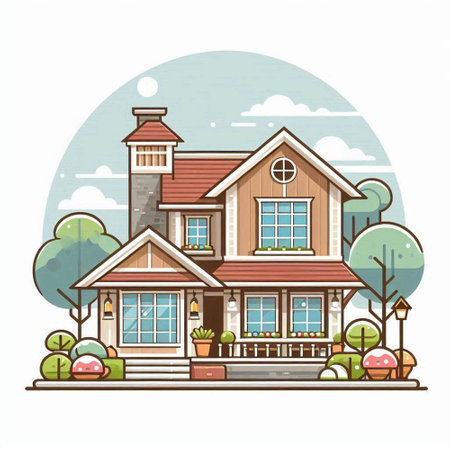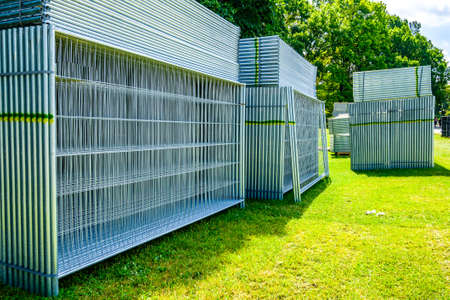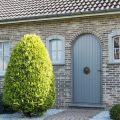Introduction to Contemporary Fence Aesthetics
In today’s American neighborhoods, the fence has evolved far beyond its traditional role as a simple boundary marker. Modern fence design is now a key architectural element that significantly impacts a homes curb appeal. Homeowners are increasingly recognizing that the right fence can transform the exterior look of their property, making it more inviting and stylish while complementing the overall landscape. Whether in bustling urban communities or tranquil suburban streets, contemporary fencing solutions are being used to make bold design statements, showcase personal style, and boost property value. This growing emphasis on aesthetic-driven fence choices reflects a broader trend in American home improvement—where first impressions matter, and every exterior detail counts.
Material Innovations and Sustainability
Modern fence design in the U.S. is rapidly evolving to reflect growing homeowner demand for eco-friendly solutions and long-lasting performance. Today’s top fencing trends prioritize both sustainability and durability, pushing manufacturers and contractors to adopt advanced materials that not only boost curb appeal but also minimize environmental impact. Among the most notable innovations are composite fencing, reclaimed wood, and powder-coated steel—each offering unique advantages for American homes.
Composite Fencing: Low-Maintenance & Eco-Friendly
Composite fencing is crafted from a blend of recycled plastics and wood fibers, resulting in a material that resists rot, warping, and insect damage far better than traditional lumber. Homeowners appreciate its minimal maintenance requirements—there’s no need for regular staining or painting—and its modern aesthetic fits seamlessly into contemporary landscapes.
Reclaimed Wood: Character with a Conscience
For those seeking a more rustic or natural look, reclaimed wood has become a leading trend. By repurposing timber from barns, factories, or shipping pallets, this approach diverts waste from landfills while delivering one-of-a-kind character and warmth. Reclaimed wood fences can be treated to improve their longevity without compromising their eco-friendly credentials.
Powder-Coated Steel: Strength Meets Style
Powder-coated steel offers superior durability compared to traditional wrought iron or aluminum options. The powder-coating process creates a tough, weather-resistant finish that stands up to the harshest American climates without rusting or fading. This technology allows for a broad selection of colors and styles, enabling homeowners to customize their fence while benefiting from decades-long performance.
Comparative Overview of Modern Fencing Materials
| Material | Key Benefits | Sustainability Features |
|---|---|---|
| Composite | Low maintenance, resistant to decay/insects | Made from recycled plastics/wood fibers |
| Reclaimed Wood | Unique appearance, versatile style | Reduces landfill waste, repurposes existing materials |
| Powder-Coated Steel | High strength, customizable color/finish | Long lifespan reduces replacement frequency |
The Future of Sustainable Fencing Design
The adoption of these innovative materials reflects an ongoing shift in American home design priorities—where aesthetics must go hand-in-hand with responsibility and resilience. As material technology continues to advance, expect even more options that balance beauty with sustainability in modern fencing projects across the country.

3. Popular Styles and Patterns
Modern American neighborhoods are embracing innovative fence designs that move far beyond traditional pickets or plain panels. Among the most sought-after trends, horizontal slats have become a staple for homeowners seeking a sleek, contemporary look. These slats, often crafted from wood, composite, or metal, create clean lines that visually expand outdoor spaces and deliver a minimalist aesthetic that pairs well with modern architecture.
Another rising trend is the use of geometric motifs. Fences featuring bold patterns—such as chevrons, lattice grids, or repeating diamond shapes—add architectural interest and dynamic curb appeal. These geometric elements can be incorporated into full panels or serve as decorative inserts within classic frames, providing both style and partial privacy.
For those wanting to make an even bolder statement, mixed-material designs are gaining traction in contemporary American landscapes. By combining materials like wood with powder-coated steel or incorporating frosted glass panels alongside aluminum, homeowners achieve a custom look that balances warmth, durability, and visual intrigue. This fusion not only enhances the fence’s functionality but also contributes to a distinctive neighborhood identity.
Ultimately, these popular styles reflect current preferences for personalization, low-maintenance solutions, and integration with home exteriors. Selecting one of these trending designs can significantly boost your property’s curb appeal while ensuring it stands out in any modern community.
Smart Features and Outdoor Technology
Modern fence design is increasingly defined by the integration of smart features and advanced outdoor technologies. Homeowners across the United States are embracing innovative fencing solutions that not only enhance security but also boost curb appeal and convenience. As technology evolves, fences are no longer just static barriers—they are becoming interactive components of a connected home environment.
Integrating Smart Locks for Enhanced Security
One of the most popular trends in modern fencing is the use of smart locks. These devices offer keyless entry options, remote access control via smartphone apps, and activity monitoring, providing peace of mind for families. Many smart locks can be seamlessly installed on gates made from wood, vinyl, or metal, making them versatile for various design aesthetics.
Automated Gates: Convenience Meets Style
Automated gates are quickly becoming a hallmark of upscale curb appeal. Powered by reliable motors and controlled through remotes or mobile devices, these gates combine functionality with visual sophistication. Automated swing or sliding gates are available in a range of materials and finishes, allowing homeowners to match their overall landscape design while enjoying hands-free operation.
Outdoor Lighting for Ambiance and Safety
Incorporating lighting elements into fencing not only creates an inviting nighttime appearance but also increases safety. LED strip lights, solar-powered post caps, and motion-activated fixtures are now standard features in modern fence installations. These lighting solutions highlight architectural details while providing illumination along walkways and driveways.
Comparison Table: Popular Smart Fence Features
| Feature | Main Benefits | Popular Applications |
|---|---|---|
| Smart Locks | Keyless entry, remote access, activity tracking | Residential side gates, driveway gates |
| Automated Gates | Convenience, enhanced security, aesthetic value | Main entrances, commercial properties |
| LED & Solar Lighting | Improved visibility, energy efficiency, ambiance | Picket fences, privacy fences, perimeter fencing |
The Future of Fencing: Connected Curb Appeal
The integration of smart technologies into fencing is shaping the future of American homes. By choosing intelligent locks, automated gates, and creative lighting systems, homeowners can achieve a balance between modern security needs and stunning curb appeal—setting their property apart in any neighborhood.
5. Color Palettes and Custom Finishes
One of the most impactful ways to elevate curb appeal with modern fence design is through strategic use of color palettes and custom finishes. In recent years, American homeowners have moved beyond traditional wood stains and basic white paints, gravitating toward bold, neutral, and textured options that harmonize with their home’s architectural identity.
Bold Choices for Contemporary Homes
Contemporary fence trends often feature deep charcoal, matte black, or even dramatic navy blue finishes. These colors create a striking contrast against lighter exterior walls or vibrant landscaping, making the fence a statement piece while maintaining a sophisticated look. Powder-coated steel and aluminum fences in these shades are especially popular in urban settings where minimalism is celebrated.
Neutral Tones for Timeless Appeal
For those looking to achieve a classic or transitional style, neutral palettes such as taupe, warm grays, and soft whites remain prevalent. These hues offer versatility and blend seamlessly with various siding materials like brick, stone, or natural wood. Neutral tones also age gracefully and are less prone to looking dated as trends evolve, providing long-term value for American homes.
Textured Finishes: Adding Depth and Character
Custom textured finishes—like brushed metal, sandblasted wood, or composite materials with embossed patterns—are gaining traction among U.S. homeowners who want both durability and visual interest. These textures not only hide wear over time but also complement homes with Craftsman, farmhouse, or mid-century modern influences by adding tactile depth to the property’s perimeter.
Matching Fence Finishes to Home Architecture
The key to selecting the right finish lies in understanding your home’s architectural style. For example, a sleek black horizontal slat fence pairs well with modern builds, while a cedar-tone stain can highlight the rustic charm of cottage-style residences. Ultimately, today’s fence color and finish trends empower homeowners to express individuality while enhancing overall curb appeal.
6. Local Regulations and Neighborhood Influences
When planning a modern fence that enhances curb appeal, it’s crucial to consider the impact of local regulations and neighborhood influences in the United States. Across different states, cities, and even neighborhoods, homeowners face a diverse array of zoning codes, building permits, and homeowners’ association (HOA) guidelines that directly shape fence design choices.
Understanding Regional Codes
Building codes vary significantly by region and municipality. In some states like California or Florida, there are strict requirements regarding fence height, material types, and placement—often for safety or environmental reasons. For example, pool fences must meet specific standards for child safety, while urban areas may limit front yard fence heights to preserve sightlines and community aesthetics.
HOA Guidelines and Community Standards
If you live in a neighborhood governed by an HOA, expect detailed rules about acceptable fence styles, colors, materials, and dimensions. Many HOAs prioritize cohesive curb appeal by mandating uniform designs or approved palettes—such as black aluminum or white vinyl—while prohibiting bold customizations that could disrupt visual harmony. Before finalizing your modern fence plan, always consult your HOA covenants to avoid costly compliance issues.
Local Culture and Design Trends
American regional culture also plays a significant role in fence design trends. In the Pacific Northwest, eco-friendly and sustainable materials like cedar or composite are popular due to environmental values. Southwestern homes may favor adobe-inspired walls or wrought iron with geometric motifs reflecting Hispanic heritage. Meanwhile, in historic districts across New England or the South, traditional picket fences are often preferred to complement colonial architecture. Choosing a modern fence that resonates with local culture not only boosts curb appeal but also adds value by blending seamlessly into the neighborhood context.
Navigating these regulatory and cultural factors is essential for any homeowner aiming for both style and compliance. By aligning your modern fence design with local codes, HOA standards, and regional influences, you’ll ensure a result that enhances your property’s appearance while maintaining good standing within your community.
7. Maintenance, Longevity, and Return on Investment
When evaluating modern fence design trends for your property, it’s essential to look beyond aesthetics and consider the long-term practicality of your investment. The latest fence materials—such as powder-coated steel, composite panels, and premium vinyl—are engineered for minimal maintenance, resisting rot, warping, and insect damage far better than traditional wood options. Homeowners should prioritize finishes that offer UV protection and weather resistance, ensuring the fence remains attractive with only occasional cleaning or touch-ups.
Maintenance Best Practices
Modern fences typically require less frequent attention than older styles, but a proactive approach can extend their lifespan significantly. For metal fences, periodic inspections for rust or loose hardware are key; a quick rinse with a garden hose removes dust and debris. Composite and vinyl fences benefit from gentle soap-and-water cleaning to prevent staining or mildew buildup. In all cases, prompt repairs of minor damage help avoid costly replacements down the road.
Expected Lifespan of Modern Fencing Materials
Today’s advanced fencing materials are designed with longevity in mind. Powder-coated aluminum and steel fences can last 30 years or more with minimal upkeep. High-quality composite fences often come with warranties of 25 years or longer, while top-tier vinyl products routinely exceed two decades before showing significant wear. By selecting durable materials and trusted manufacturers, homeowners ensure that their curb appeal upgrade stands the test of time.
Adding Value: ROI Considerations
Investing in a well-designed modern fence offers tangible returns beyond mere visual enhancement. According to real estate professionals in the U.S., properties with stylish, low-maintenance fencing often command higher asking prices and attract more buyers due to perceived security, privacy, and overall polish. A contemporary fence can yield a return on investment ranging from 50% to over 70%, depending on the material, quality of installation, and regional market trends. Ultimately, choosing a modern fence not only elevates your home’s curb appeal but also strengthens its value proposition should you decide to sell.


